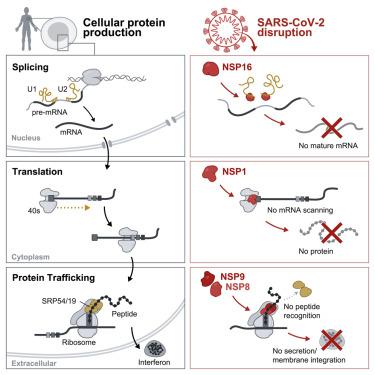Cell ( IF 45.5 ) Pub Date : 2020-10-08 , DOI: 10.1016/j.cell.2020.10.004 Abhik K Banerjee 1 , Mario R Blanco 2 , Emily A Bruce 3 , Drew D Honson 2 , Linlin M Chen 2 , Amy Chow 2 , Prashant Bhat 4 , Noah Ollikainen 2 , Sofia A Quinodoz 2 , Colin Loney 5 , Jasmine Thai 2 , Zachary D Miller 6 , Aaron E Lin 7 , Madaline M Schmidt 3 , Douglas G Stewart 5 , Daniel Goldfarb 5 , Giuditta De Lorenzo 5 , Suzannah J Rihn 5 , Rebecca M Voorhees 2 , Jason W Botten 3 , Devdoot Majumdar 6 , Mitchell Guttman 2

|
Severe acute respiratory syndrome coronavirus 2 (SARS-CoV-2) is a recently identified coronavirus that causes the respiratory disease known as coronavirus disease 2019 (COVID-19). Despite the urgent need, we still do not fully understand the molecular basis of SARS-CoV-2 pathogenesis. Here, we comprehensively define the interactions between SARS-CoV-2 proteins and human RNAs. NSP16 binds to the mRNA recognition domains of the U1 and U2 splicing RNAs and acts to suppress global mRNA splicing upon SARS-CoV-2 infection. NSP1 binds to 18S ribosomal RNA in the mRNA entry channel of the ribosome and leads to global inhibition of mRNA translation upon infection. Finally, NSP8 and NSP9 bind to the 7SL RNA in the signal recognition particle and interfere with protein trafficking to the cell membrane upon infection. Disruption of each of these essential cellular functions acts to suppress the interferon response to viral infection. Our results uncover a multipronged strategy utilized by SARS-CoV-2 to antagonize essential cellular processes to suppress host defenses.
中文翻译:

SARS-CoV-2 破坏剪接、翻译和蛋白质运输以抑制宿主防御
严重急性呼吸综合征冠状病毒 2 (SARS-CoV-2) 是最近发现的一种冠状病毒,可导致称为 2019 年冠状病毒病 (COVID-19) 的呼吸道疾病。尽管迫切需要,但我们仍然不完全了解 SARS-CoV-2 发病机制的分子基础。在这里,我们全面定义了 SARS-CoV-2 蛋白与人类 RNA 之间的相互作用。NSP16 与 U1 和 U2 剪接 RNA 的 mRNA 识别域结合,并在 SARS-CoV-2 感染时抑制全局 mRNA 剪接。NSP1 与核糖体 mRNA 进入通道中的 18S 核糖体 RNA 结合,导致感染后 mRNA 翻译的全局抑制。最后,NSP8 和 NSP9 与信号识别颗粒中的 7SL RNA 结合,并在感染后干扰蛋白质向细胞膜的运输。破坏这些基本细胞功能中的每一个都会抑制干扰素对病毒感染的反应。我们的研究结果揭示了 SARS-CoV-2 利用多管齐下的策略来对抗基本细胞过程以抑制宿主防御。











































 京公网安备 11010802027423号
京公网安备 11010802027423号